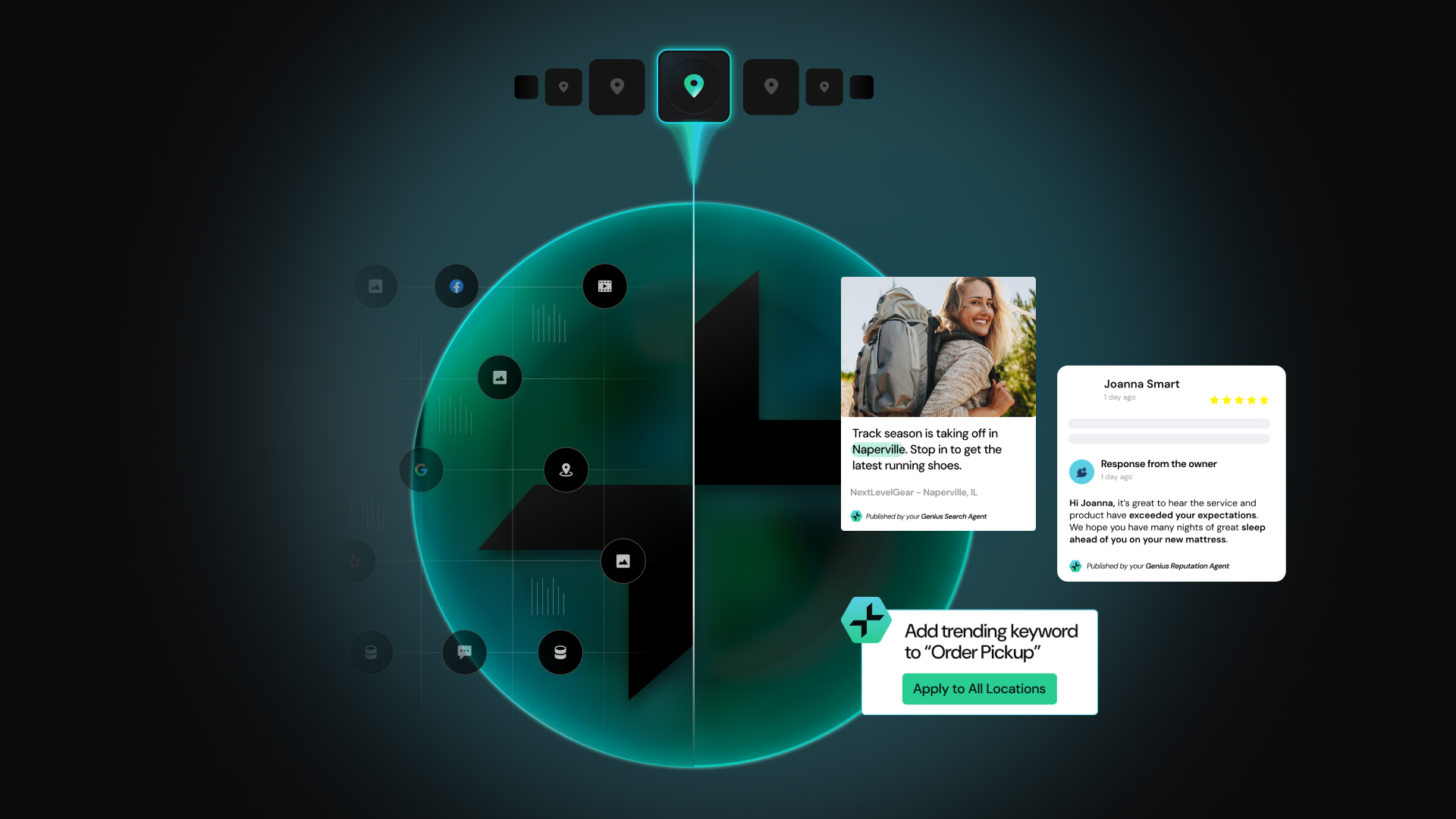What Does Google’s Search Generative Experience Mean for Search and SEO?
What Does Google’s Search Generative Experience Mean for Search and SEO?
Search Generative Experience: The Backstory
Google has been working at a fever pitch over the last several months to respond to the threat represented by OpenAI’s ChatGPT, the generative AI chatbot that took the world by storm when it was launched to the public in November 2022. Though Google has been using AI for years to improve the relevance of search results, models like RankBrain, BERT, and MUM operated in the background, and most consumers were unaware that they even existed.
ChatGPT changed all that by bringing AI front and center in the user experience, and wowed users with its ability to respond to historical questions, compose songs and poems, tell jokes, and write computer code. Its skill at retrieving and synthesizing information, derived from ingesting huge chunks of the internet, seemed right away to represent an existential threat to what we’ve started to call “traditional search,” and Google’s highly popular search platform looked like it might be headed toward second-class status.
When Microsoft, an early OpenAI investor, acted at lightning speed to bring ChatGPT technology to Bing, the threat to Google became even more direct. The Bing chatbot even supports local search:

Google has responded with a rapid-fire series of initiatives, including the launch of the web-connected Bard chatbot and now the launch of the experimental Search Generative Experience (SGE), that may come to represent at least as great a change in search as what took place with the Great Mobile Shift of 2015. Just as smartphone usage transformed our conception of using the internet for specific time and location-based needs, so too does generative AI change the way we think about interacting with web content.
If AI fulfills its promise, we will no longer need to visit third-party websites for many of the kinds of questions that cause us to turn to search, because the answers will be presented to us directly in the search result page in a useful and digestible manner.
What’s more, we’ll be able to use AI to do things that go beyond any traditional definition of search, such as providing instruction, recommendations, and tools to accomplish tasks like booking a flight or calculating the cost of a new car purchase.
Of course, many similar features were already available in Google search in the form of rich snippets and Knowledge Graph content. Ask Google for the definition of “abstruse” or the birthdate of Richard Nixon, and you’ll get your answer without having to click through to a website. Google moved beyond ten blue links a long time ago, and it’s unclear as yet just how different SGE will be from the enhanced search interface we’ve already grown accustomed to.
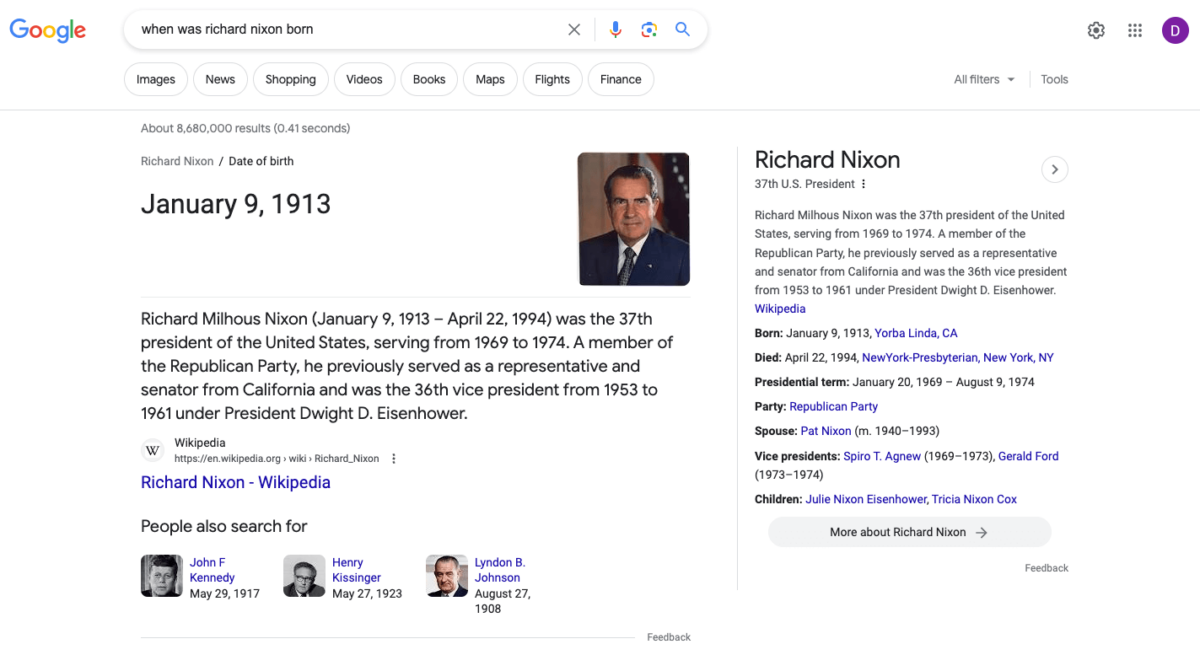
What we’re facing, then, may not be a dramatic change in the content of search results, but rather a paradigm shift whereby the search engine finally, fully becomes an answer engine, foregrounding generative responses and utilizing content from the broader web more as a support structure, much like Wikipedia uses references. If so, this is the realization of a notion that’s been gestating ever since Google launched the Knowledge Graph in 2012 — or perhaps since Tim Berners-Lee first dreamed of a Semantic Web.
What SGE Looks Like Today
The initial launch of the Search Generative Experience is an experimental release that is only available via a waiting list to Chrome users with personal Google accounts. (You can sign up at labs.google.com/search.) Once access is granted, you can toggle SGE to “on” by visiting the Labs website or clicking on the Labs icon in the Google mobile app. The documentation states that the experimental release will expire in December 2023, though it’s been rumored that Google will do a full public rollout before that date.
Another important note on the Labs site states, “When turned on, SGE may appear when you search.” In other words, not all searches trigger the Snapshot window that contains SGE results. There are three possibilities when you type in a query:
- You’ll see a traditional search result.
- You’ll see a Snapshot section at the top of the SERP, followed by traditional search content.
- You’ll see a small Snapshot callout that reads, “Get an AI-powered overview for this search?” with a button that reads “Generate.”
It’s not entirely clear how Google is distinguishing between these options. Some queries of the “Your Money or Your Life” (YMYL) variety, for example — where the result contains information that could impact your health or financial well-being — return SGE results while some do not. Local searches also vary between the three result types. It’s highly likely that Google is experimenting constantly with SGE as users interact with the new tool, in order to dial in the optimal user experience.
Here’s a search suggested by Google when you first launch SGE, for “underrated summer travel ideas”:
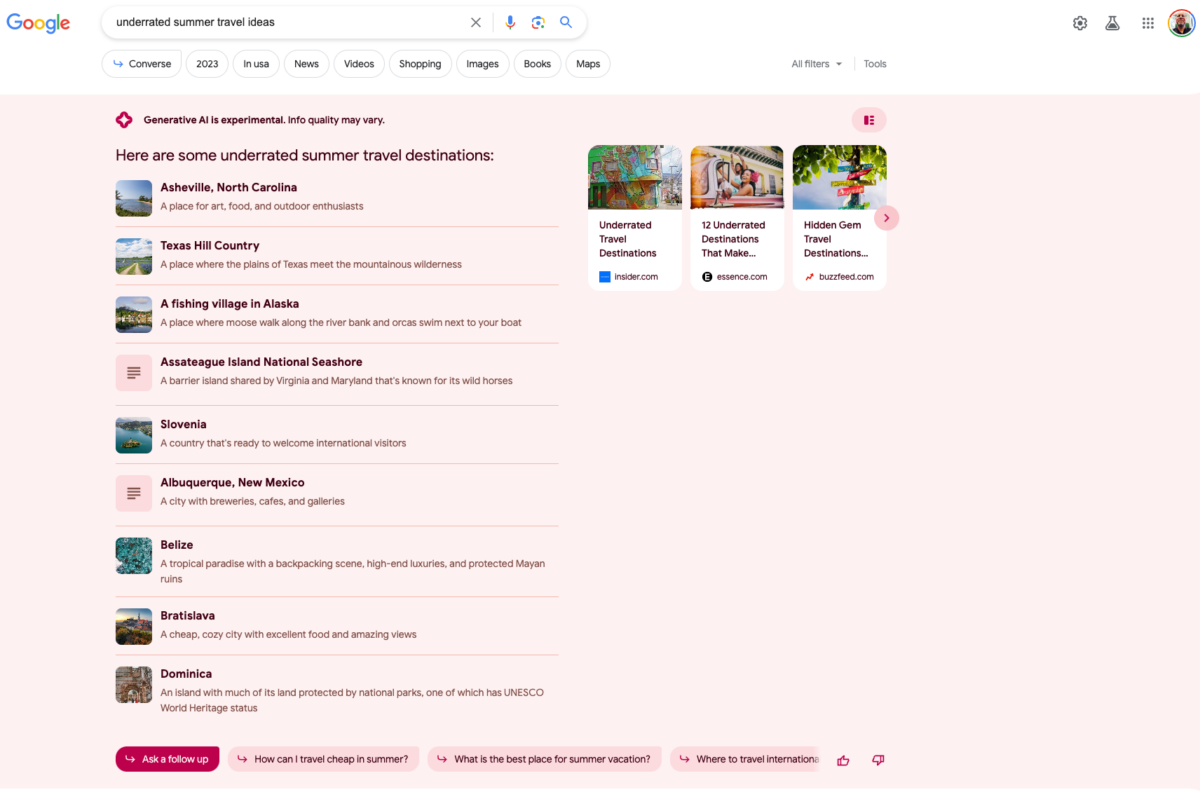
Basically, this is a well-organized list of travel destinations with a bit more visual appeal than the typical featured snippet result. Clicking on any of the photos in the results launches a popup window with image-focused results for each destination. A prominent “card carousel” display on the top right shows links to sites with additional lists of travel ideas, some of them references for the SGE results. Clicking on the icon in the top right corner of the Snapshot changes the display so that every item is annotated with a “link card.”
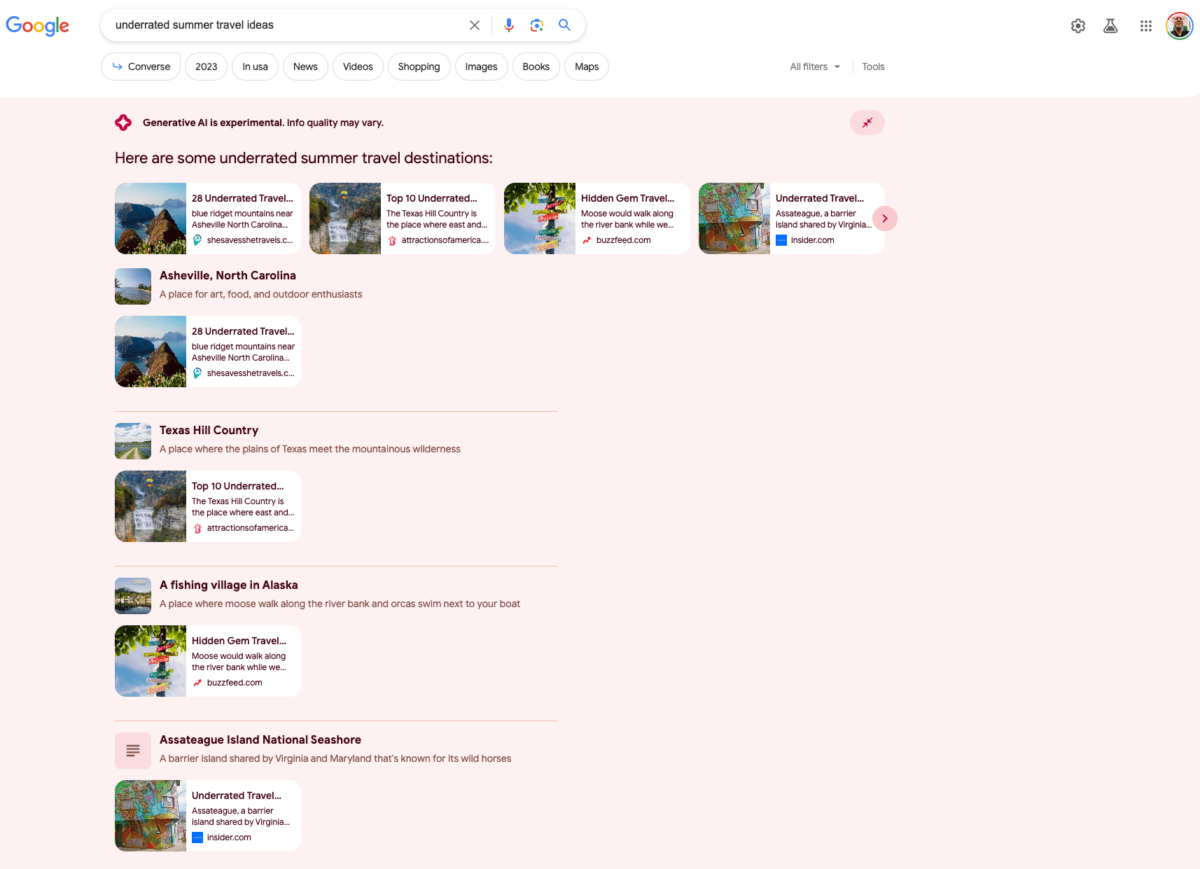
Probably the most distinctive feature of SGE is the list of prompts at the bottom of the Snapshot area. For this search, the prompts read, in order: “Ask a follow up”; “How can I travel cheap in summer?”; “What is the best place for a summer vacation?”; and “Where to travel internationally this summer?”
Among these, “Ask a follow up” is the most innovative — for the first time, users don’t have to restart with a different query when searching for something more specific, but instead can use SGE to refine their intent and, theoretically, find the exact answer they’re looking for.
How does this work in practice? Clicking “As a follow up” invokes a chat-style interface. If I type in “Which of these travel destinations is the most affordable and family-friendly?” I would expect the result would help me to refine the list Google has already provided. Instead, I’m given a completely new list of destinations, with Belize being the only destination shared between the two results.
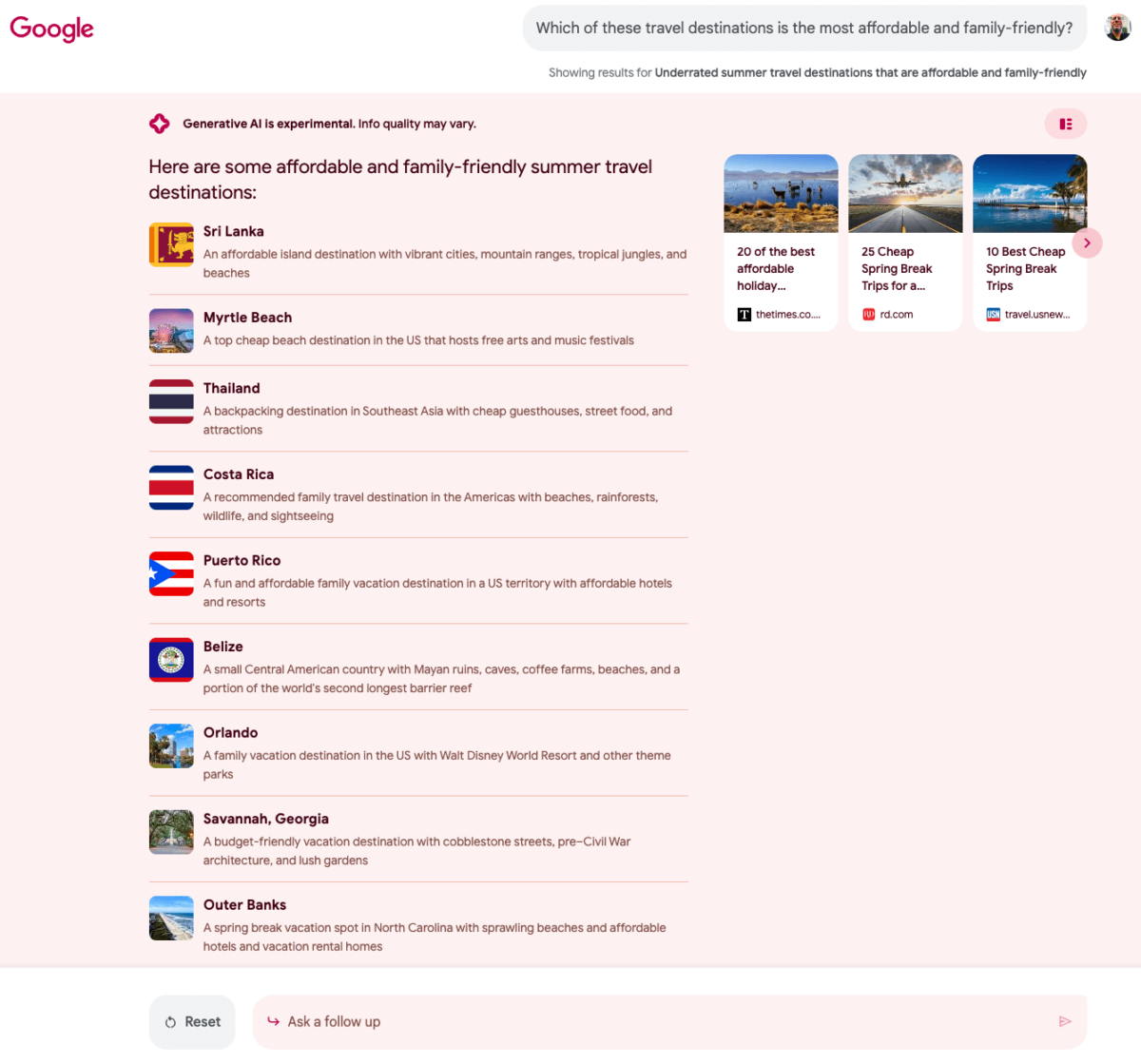
To be fair, ChatGPT too is often subject to these kinds of clunky responses, where the interpretation of user intent leaves a lot to be desired. Like much of what we’ve seen in generative AI, SGE offers the promise of a user experience that exceeds what it can currently deliver.
How SGE Handles Local Queries
What’s immediately notable about the SGE interface when it comes to local queries is that Google has clearly identified them as an important use case, backing up prior statements on the company’s part that nearly half of all Google queries have some kind of local intent. Indeed, in the initial launch of SGE, local queries are represented in a manner that suggests special attention was given to them. Here’s an example for “best restaurants for a group dinner in Chicago”:
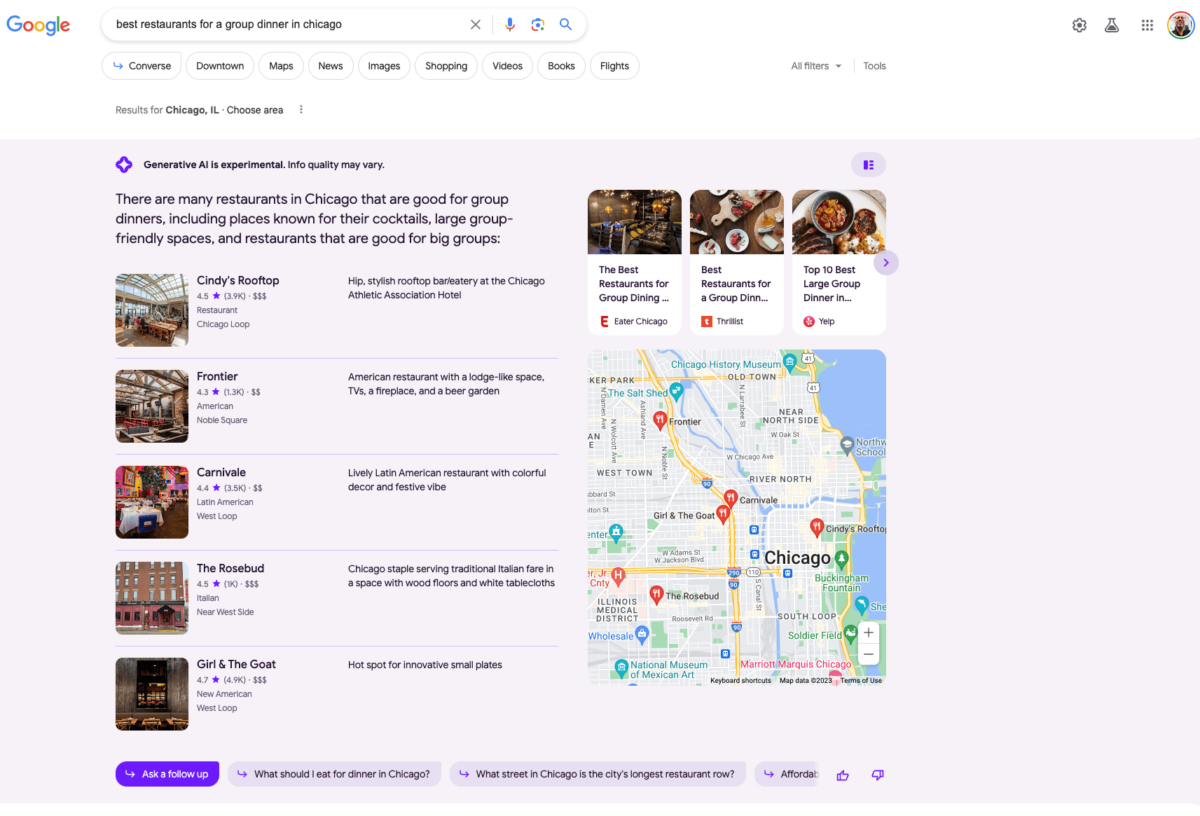
Notably, the SGE version of this search result differs from that of a typical Google 3-Pack by providing contextual commentary, a description of each restaurant option, links to third-party sites, prompts to ask a follow-up question, and five results in contrast to the normal three. On the other hand, there’s no link to view more results, suggesting that businesses ranking lower than position five may never be seen unless the user thinks to ask for more options.
Another notable detail is the difference between SGE and organic results. In this example, Cindy’s Rooftop is the top-ranked result, followed by Frontier and Carnivale. Further down the page, the 3-Pack shows a completely different order of businesses, with Cindy’s Rooftop now occupying position three.
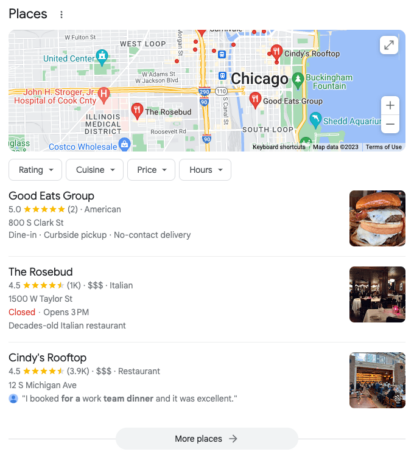
Similarly, the top three third-party sites listed in the link carousel at the top right of the SGE section are Eater Chicago, Thrillist, and Yelp; of these, only Eater Chicago retains its top ranking in the organic results further down the page, where it is followed by links from Bucket Listers and The Infatuation.
The point here is that rankings for Google Business Profiles, as well as organic local listings, are not at all identical in SGE when compared to traditional search. These are early days, but the implication behind these findings is that generative AI has a very different methodology for ranking search results. This is the kind of thing that makes SEOs sit up and pay attention. The rules of the game may be changing as we speak.
Again, one would hope that the promise of asking follow-up questions would open up new possibilities for local search. In that spirit, I asked in response to the result above, “Which of these options is best for a group where some people have dietary restrictions such as vegetarian, vegan, or gluten-free?”
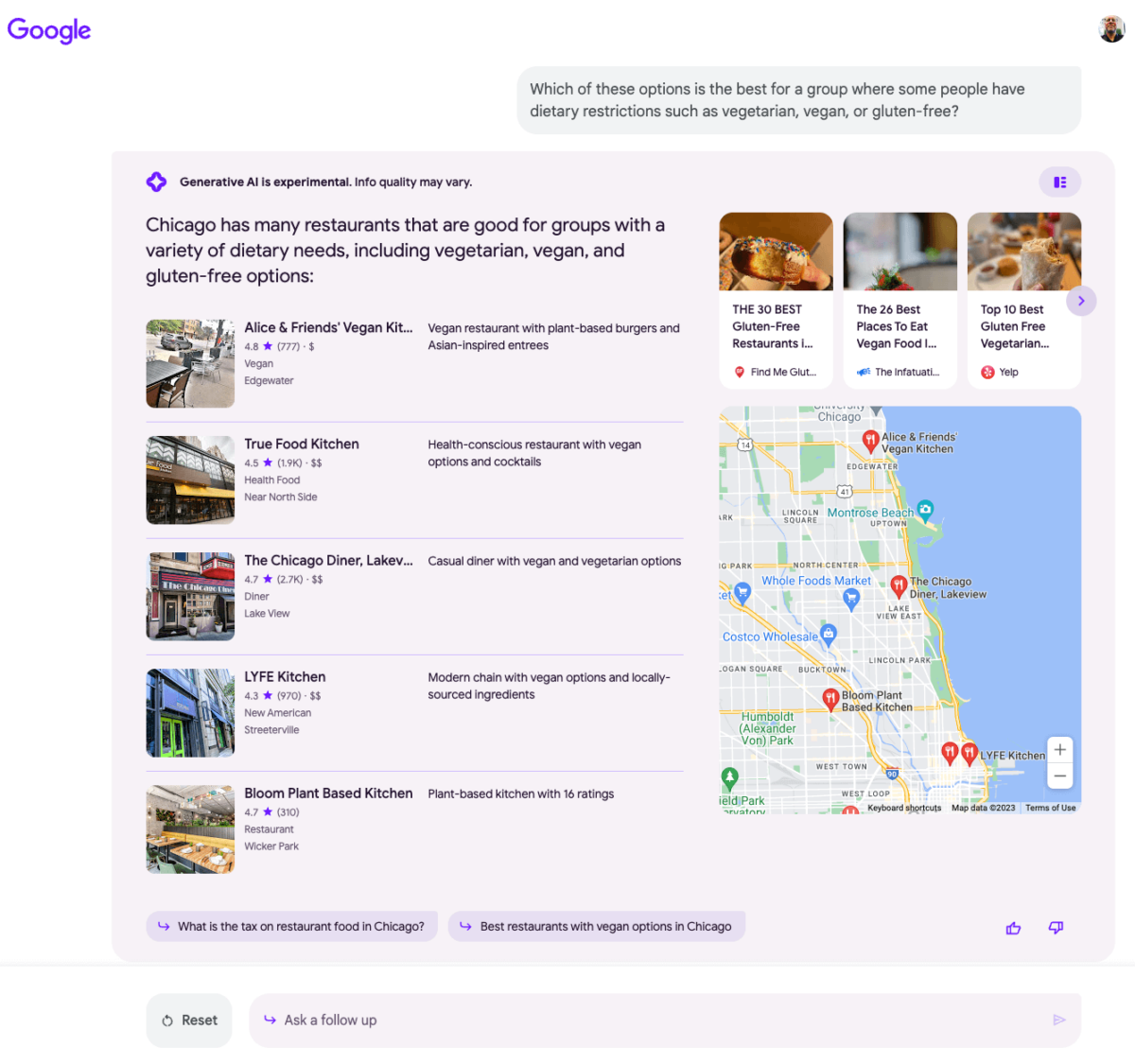
As with the travel example earlier, I’m presented here with an entirely new list of results, some of them relevant to my query — I’m looking for a restaurant that caters both to meat eaters and to those with the specified dietary needs — but none matching the prior results I asked SGE to refine.
Again, the promise exceeds the current state of things. But we’re living through an era of extremely rapid development of AI capabilities, and it likely won’t be long before interfaces like SGE begin delivering on the capabilities their features are designed to produce.
What Does SGE Mean for SEO?
It’s of course too early for SEO practitioners to completely rethink their current methodologies, but it has to be acknowledged that generative AI is much more than a passing fad. The evidence is already abundant that AI will change the way we live, work, and interact with software in a dramatic fashion — if you need a sign, just look at the fact that IBM recently forecasted that 30% of its back-office workforce would be replaced by AI in the next five years. (There are, of course, much larger implications for the global economy as a whole.)
So it’s clear that SEOs will at least need to begin thinking seriously about the new priorities AI may place on search optimization activities. If the conversational nature of SGE ends up fulfilling on its promise, it will be especially important for websites and local profiles to offer the kinds of fine-grained differentiating information that AI will need in order to answer complex and nuanced questions from consumers with very specific needs.
And early indications suggest that the ranking and relevance factors utilized by AI are not the same as those of traditional search, suggesting that SEOs may need to learn a new set of rules moving forward.
There’s a lot of “it depends” about all of this at the moment, but we do know that AI is not going away.
As Google CEO Sundar Pichai recently said in an interview, search “will evolve substantively over the next decade” in the direction of flexibility and personalization, becoming “ambiently available to users in radically different ways.” Just as the Great Mobile Shift launched the app ecosystem, generative search may represent a tipping point that creates significant greenfield opportunities, as well as new challenges.

